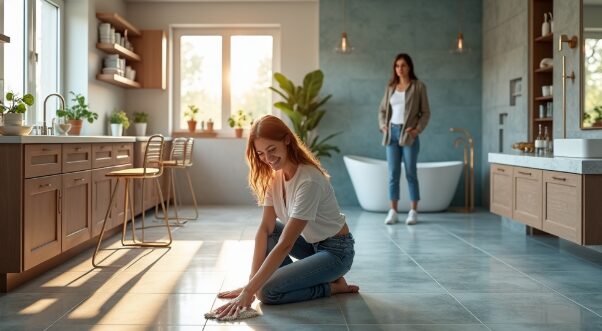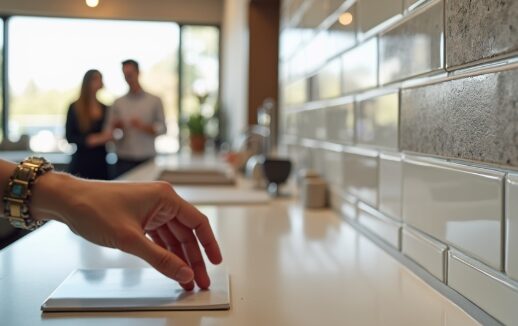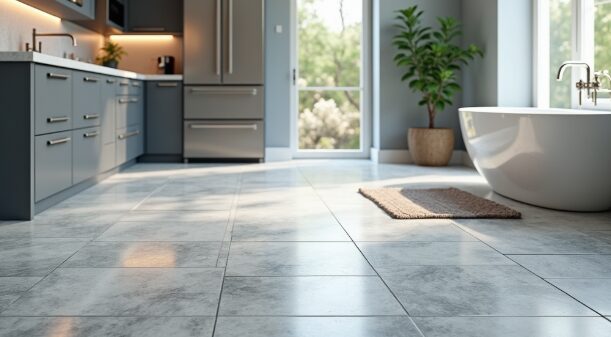Tile flooring for kitchens and bathrooms is a fantastic choice due to its durability, ease of cleaning, and timeless aesthetic appeal. It works beautifully in any space, making it both a practical and stylish option. However, with so many styles and materials available, it can be overwhelming to know where to start.
his guide will help you navigate everything you need to know about tile flooring for these essential areas in your home. For expert advice and flawless installation, consider professional floor installation services in Vancouver.
Table of Contents
Key Takeaways
- Durability: Tile floors can last a long time, making them a smart choice for busy spaces.
- Easy to Clean: Spills and stains are easy to wipe away, keeping your home looking nice.
- Variety: There are many styles, colors, and materials to choose from, ensuring you find the perfect fit.
- Water-Resistant: Tile is ideal for bathrooms and kitchens because it handles moisture well.
- Installation: Proper installation is key to making your tile floor last.
For more on creating beautiful spaces in your home, check out our guide on designing modern interiors.
Why Choose Tile Flooring for Kitchens and Bathrooms?

Tile is one of the best materials for both kitchens and bathrooms. Here are some reasons why.
Long-lasting Durability
Tile floors can handle heavy foot traffic. They do not scratch or dent easily. This makes them a good choice for busy homes, especially with kids and pets. In Vancouver, where rainy weather is common, tile can withstand moisture without damage.
Easy Maintenance
Cleaning tile is simple. You can sweep or vacuum to remove dirt and debris. For spills, a damp cloth or mop is all you need. Unlike carpets, tile does not absorb stains or odors.
Design Options
Tile comes in many styles. You can choose from classic ceramic, sleek porcelain, or even natural stone. There are countless colors and patterns, so you can match your flooring to your kitchen or bathroom design.
Water Resistance
The tile is naturally water-resistant. This feature is essential in bathrooms and kitchens where moisture is common. With tile, you do not have to worry about mold or mildew forming.
| Tile Type | Durability | Water Resistance | Maintenance |
|---|---|---|---|
| Ceramic | Moderate | Moderate | Easy |
| Porcelain | High | Very High | Easy |
| Natural Stone | High | Moderate | Moderate |
| Vinyl | Low | High | Very Easy |
Selecting the Perfect Tile Flooring

When picking tile for your space, consider your style and needs. Here are some options to think about.
Ceramic Tile
Ceramic tile is very popular. It is affordable and comes in many colors and patterns. You can find it in both glossy and matte finishes. Ceramic is also easy to clean, making it a great choice for kitchens.
Porcelain Tile
Porcelain tile is denser than ceramic. It is even more durable and has a lower absorption rate. This makes it a good option for high-moisture areas like bathrooms. Porcelain tiles can mimic the look of wood or stone, offering a stylish appearance.
Natural Stone Tile
Natural stone, like granite or marble, adds elegance to any room. Each tile is unique, giving your space character. However, stone requires more upkeep and sealing to prevent stains.
Vinyl Tile
Vinyl tile is a budget-friendly option. It is softer underfoot and can mimic the look of other materials, like wood or stone. Vinyl is also water-resistant, making it suitable for kitchens and bathrooms.
- Consider the overall theme of your home when selecting a tile.
- Think about the texture of the tile, especially for wet areas.
- Factor in the foot traffic your flooring will endure.
- Evaluate the climate in your area, as it may affect tile choice.
Tile Flooring for Kitchens and Bathrooms Sizes and Shapes

Tiles come in various sizes. Choosing the right size can change the look of your space.
Square and Rectangular Tiles
Square tiles are classic. They can be small, like 12×12 inches, or larger, like 24×24 inches. Rectangular tiles, like 12×24 inches, can create a modern look.
Mosaic Tiles
Mosaic tiles are small pieces that come in sheets. They are perfect for creating detailed patterns. They work well as accents or in small spaces like shower stalls.
Plank Tiles
Plank tiles are long and narrow. They are often used to mimic hardwood floors. Plank tiles can add warmth to a bathroom or kitchen.
Color and Pattern Selection
The right color and pattern can make a big difference in your space.
Light vs. Dark Colors
Light colors can make a small space feel larger. They reflect light and can brighten up a room. Dark colors can add depth and drama, making larger spaces feel cozy.
Patterns and Textures
Patterns can add interest to your floor. You might choose herringbone or checkerboard designs. Textured tiles can also help prevent slipping, which is important in wet areas like bathrooms.
Kitchens and Bathrooms Installation Tips
Installing tile flooring in kitchens and bathrooms requires careful planning and precision to ensure a flawless and long-lasting finish. Begin by selecting tiles designed to withstand high moisture levels and heavy foot traffic, such as ceramic or porcelain.
Prep the subfloor thoroughly—make sure it’s clean, dry, and level to avoid uneven tiles or cracking over time. Use a high-quality waterproof underlayment to protect against water damage. When laying tiles, start from the center of the room for a balanced design and use spacers for consistent grout lines. Finally, apply a waterproof grout and seal it to prevent stains and moisture buildup.
Proper installation ensures a durable and attractive floor that enhances your space. Proper Floor Installation Services in Vancouver are vital for the long-lasting performance of your tile floor. Therefore, it is important to hire professional floor installers who have the expertise and experience to ensure a seamless and precise installation. They will follow all the essential tips for flawless finish, such as proper subfloor preparation, accurate measurements, and meticulous attention to detail. By entrusting your floor installation to skilled professionals, you can rest assured that your tile floor will not only look beautiful but also withstand the test of time.
Prepare the Subfloor
The subfloor must be clean and level. Any bumps or debris can cause tiles to crack or shift. If you have old flooring, it may be best to remove it first.
Use the Right Adhesive
Choosing the right adhesive is crucial. There are different types for different tile materials. Be sure to follow the manufacturer’s recommendations for the best results.
Allow for Expansion
Tiles need room to expand and contract with temperature changes. Use spacers between tiles to allow for this movement. This will help prevent cracks.
Grouting and Sealing
After the tiles are laid, grout fills the spaces between them. Grout needs to be sealed to prevent stains and water damage.
For more detailed guidance on home remodeling projects, check out our resources.
Caring for Your Tile
Tile flooring in kitchens and bathrooms is both stylish and durable, but it requires proper care to maintain its beauty and longevity. Regular sweeping or vacuuming prevents dirt and debris from scratching the surface while mopping with a mild cleaner keeps tiles fresh and stain-free.
Pay special attention to the grout lines, which can accumulate dirt and moisture, leading to discoloration or mold. Sealing grout periodically can protect against stains and extend its life. With consistent upkeep, your tile flooring will remain a stunning and practical feature in your home for years to come. To keep your tile floor looking great, follow these care tips.
Regular Cleaning
Sweep or vacuum regularly to remove dirt. Mop with a gentle cleaner to keep it shiny. Avoid harsh chemicals that can damage the tile or grout.
Addressing Grout Issues
Grout can discolor over time. Clean it with a mixture of vinegar and water. For tougher stains, a grout cleaner can help. If grout lines start to crack, it may need to be replaced.
Preventing Scratches
While tile is durable, it can still scratch. Use furniture pads under heavy items and avoid dragging furniture across the floor.
When to Replace Your Tile Flooring
Sometimes, the tile needs to be replaced. Here are signs it might be time.
Cracks and Chips
If you see cracks or chips, it can lead to bigger problems. Moisture can get under the tiles and cause damage.
Fading Colors
Over time, sunlight can fade tiles. If your floor looks dull and worn, it might be time for a change.
Loose Tiles
If tiles start to come loose, it can be a sign of a problem with the installation or substrate. This issue needs to be addressed quickly to prevent further damage.
| Maintenance Tips | Frequency | Tools Needed |
|---|---|---|
| Sweep or Vacuum | Daily | Broom, Vacuum Cleaner |
| Mop with Cleaner | Weekly | Mop, Mild Cleaner |
| Grout Cleaning | Monthly | Grout Brush, Vinegar |
| Inspect for Damage | Quarterly | Visual Inspection |
Conclusion
Tile Flooring for Kitchens and Bathrooms is a smart choice for kitchens and bathrooms. It offers durability, easy maintenance, and a wide variety of designs. With the right tile, you can create a beautiful space that lasts for years. Whether you choose ceramic, porcelain, or natural stone, tile can add value and style to your home in Vancouver, WA.
Remember to consider your needs, the installation process, and how to care for your tile floor. With these tips, you can enjoy your beautiful Tile Flooring for Kitchens and Bathrooms for a long time to come.
In summary, tile flooring is an excellent option for both kitchens and bathrooms. Its durability and easy cleaning make it ideal for these areas. The variety of styles and colors allows you to express your taste. Be sure to choose the right tile, prepare properly for installation, and maintain your floor.
This way, you can enjoy your new flooring for years. If you have any questions or need help with your next project, feel free to contact us at Prestige Construction & Home Remodeling. We’re here to help you every step of the way!

